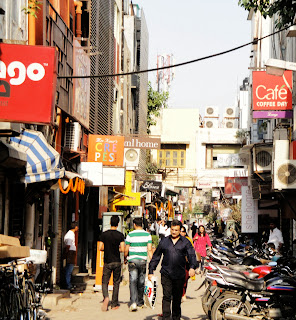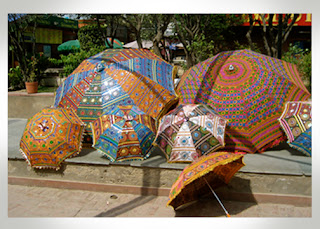Here we're talking about markets that are mainly street shops, and not housed within the four walls of a mall building. And therefore, we say Delhi's markets have 'character'. Each is different from the other in terms of the kinds of outlets, the products they offer, the brands & the restaurants.
DILLI HAAT.
 An open-air food & craft bazaar, Dilli Haat
exhibits a variety of thatched roof stalls from almost every region in India.
You’ll find beautiful hand paintings from Bihar, retro sarees from Chatissgarh,
bright-embroidered umbrellas from Rajasthan, brassware to Kolahpuri chappals
(sandals) and Pashmina shawls from Kashmir.
An open-air food & craft bazaar, Dilli Haat
exhibits a variety of thatched roof stalls from almost every region in India.
You’ll find beautiful hand paintings from Bihar, retro sarees from Chatissgarh,
bright-embroidered umbrellas from Rajasthan, brassware to Kolahpuri chappals
(sandals) and Pashmina shawls from Kashmir.
Besides all the fabulous shopping, can’t miss mentioning the variety in food
available here – you can get to try different cuisines from the different
states of India. Mouthwatering momos from Sikkim, crisp dosas from Tamil Nadu,
pao bhaji from Maharashtra to Hyderabadi biryani to name a few…
Attractions. Look out for cultural events & programs.
Entrance Fee. Rs 20/- for an adult. Rs. 10/- for children.
Where. Sri Aurobindo Marg, Opp INA
Market
JANPATH &
TIBETAN MARKET.
 Janpath is a popular & lively area with several
street shops – with both fixed & makeshift stalls. It’s a paradise for
ethnic goodies like paintings, Indian artifacts, brassware & handicrafts.
Besides this there are plenty of cheap jewellery shops with some fabulous
pieces. The market also houses one of the largest clothes export-surplus street
shops in Delhi with all international labels (ie cutoff labels) available here.
Walk towards the Tibetan market & find a spread of colorful embroidered
fabrics ranging from bed spreads to lamp shades to embroidered patches to match
your outfits to even embroidered shoes (juttis) & umbrellas.
Janpath is a popular & lively area with several
street shops – with both fixed & makeshift stalls. It’s a paradise for
ethnic goodies like paintings, Indian artifacts, brassware & handicrafts.
Besides this there are plenty of cheap jewellery shops with some fabulous
pieces. The market also houses one of the largest clothes export-surplus street
shops in Delhi with all international labels (ie cutoff labels) available here.
Walk towards the Tibetan market & find a spread of colorful embroidered
fabrics ranging from bed spreads to lamp shades to embroidered patches to match
your outfits to even embroidered shoes (juttis) & umbrellas.
Tip No. 1. Use your bargaining
skills to get a good price.
Tip No. 2. Try the cold coffee at D’Pauls, its delicious & a
ritual with Delhi-ites.
Closed. On Sundays
Where. Janpath, off Connaught Place
KHAN MARKET.
 While it is one of the most expensive street shops in
the world – but you’ll find both a street vendor selling fruits & veggies
on the side of the road & a well known designer selling through his
flagship store located right in the centre. Khan market is small & cozy, with loyal shoppers
who ONLY come to here. Book shops have been a part of this market since ages
along with tailors & dry cleaners; today it’s known for its branded stores,
small designer outlets, quirky ethnic shops & cafes. You’ll also find
street shops which sell sandals/ chappals to beautiful ‘junk’ jewellery at very
reasonable prices.
While it is one of the most expensive street shops in
the world – but you’ll find both a street vendor selling fruits & veggies
on the side of the road & a well known designer selling through his
flagship store located right in the centre. Khan market is small & cozy, with loyal shoppers
who ONLY come to here. Book shops have been a part of this market since ages
along with tailors & dry cleaners; today it’s known for its branded stores,
small designer outlets, quirky ethnic shops & cafes. You’ll also find
street shops which sell sandals/ chappals to beautiful ‘junk’ jewellery at very
reasonable prices.
What to Buy. Books from Full Circle or BahriSons. Sunglasses from
Dayal or Drishti. Fusion ‘cotton’ wear from Fab India or Anokhi. Home décor
from Oma or Good Earth or Renovation Factory. Real Jewellery from Amrapali or
Fake jewellery from the street side.
Closed. On Sundays
Where. Off Lodi Colony, Opp Golf Links
CHANDNI
CHOWK.
 One of the oldest shopping districts which was built in
the 17th century and was part of the Mughal city of Shahjahanabad.
Walking through the narrow winding alleys can be quite an adventure! Chandni
Chowk bazaar has several lanes each designated to a specific product. Bhagirath
Palace is a haven for electronics. Fabrics rule the Katra Neel lane. Dariba
Kalan is known for its silverware & silver jewellery. If you’re getting
married then you need to head towards Kinari Bazaar for all the wedding gear
& Nai Sarak for wedding cards. And our favourite place - Khari Baoli, has
spices and is one of Asia’s largest spice markets.
One of the oldest shopping districts which was built in
the 17th century and was part of the Mughal city of Shahjahanabad.
Walking through the narrow winding alleys can be quite an adventure! Chandni
Chowk bazaar has several lanes each designated to a specific product. Bhagirath
Palace is a haven for electronics. Fabrics rule the Katra Neel lane. Dariba
Kalan is known for its silverware & silver jewellery. If you’re getting
married then you need to head towards Kinari Bazaar for all the wedding gear
& Nai Sarak for wedding cards. And our favourite place - Khari Baoli, has
spices and is one of Asia’s largest spice markets.
Lastly, if you’re daring enough- try the street food
here, a variety available at every corner.
Warning. It’s not for the weak, as its quite crowded & the
alleys are very narrow.
Closed. On Sundays
Where. Old Delhi
LAJPAT NAGAR.
 Name it and you get it here. Though it’s primarily
known for material for Indian outfits, so whether you’re a fashion designer or
making an outfit for yourself – this is the place to go to for fabric &
other embellishments. And as mentioned earlier you will still manage to get
everything here from jewellery to upholstery to readymade & reasonably
priced Indian wear (salwaar kameez, lehengas etc) to food items to electronics
to household appliances… the list can go on & on.
Name it and you get it here. Though it’s primarily
known for material for Indian outfits, so whether you’re a fashion designer or
making an outfit for yourself – this is the place to go to for fabric &
other embellishments. And as mentioned earlier you will still manage to get
everything here from jewellery to upholstery to readymade & reasonably
priced Indian wear (salwaar kameez, lehengas etc) to food items to electronics
to household appliances… the list can go on & on.
Tip No. 1. Use your bargaining
skills whether in the stalls or the showrooms.
Tip No. 2. Get mehendi applied on your hands & have a bite of
the momos from the popular Tibetan carts.
Closed. On Mondays
Where: Near Ashram Chowk, Opp Defence Colony
SANTUSHTI
SHOPPING COMPLEX.
Elegant, sophisticated, tasteful. Santushti has over a
few dozen boutiques spread across an open area that is interspersed with green
laws & stoned pathways. The stores can be best described as lovely little
bungalows or huts. The boutiques range from silk scarves & bags at
Christina’s, pashmina shawls at K, cigars at Kastro's, block printed fusion
wear at Anokhi, bright cushions & other accessories at Nur & many more.
An oasis amongst the crowded Delhi markets.
Warning. Photography & haggling strictly not allowed.
Food. The only restaurant, the famous Basil & Thymes
tucked away in the corner.
Closed. On Sundays
Where. Heart of Lutyens, Opp Hotel Ashoka
HAUZ KHAS
VILLAGE.
 Located amidst 14th century heritage
structures, which include tombs, a madrasa & the breathtaking royal tank.
Today’s urban village is home to several eclectic young designers exhibiting their
passion through innovative products made of re-usable paper, fashion that
breaks the conventional norm, art that explodes your imagination, vintage
posters that bring life into the old, jewellery that makes a statement – in
short this market oozes creativity, talent & innovation.
Located amidst 14th century heritage
structures, which include tombs, a madrasa & the breathtaking royal tank.
Today’s urban village is home to several eclectic young designers exhibiting their
passion through innovative products made of re-usable paper, fashion that
breaks the conventional norm, art that explodes your imagination, vintage
posters that bring life into the old, jewellery that makes a statement – in
short this market oozes creativity, talent & innovation.
Tip No. 1. It’s a maze, so walk around ‘bindaas’ & you’ll discover something in every corner.
Tip No. 2. Take a stroll around the Deer Park & the lake.
Food. Not only shopping, but a haven for food lovers – Yeti
for Tibetan cuisine, Naivedyam for South Indian, Boheme & Amour for its
exquisite view (& ofcourse its delicious food) and plenty of cafes &
bakeries.
Closed. On Sundays
Where. Hauz Khas
SAROJINI NAGAR MARKET.
One of the city’s most popular export-surplus markets,
where you can buy ‘branded’ clothes at unbelievable prices. The area is packed
with makeshift street shops, selling a range of fashion wear – jumpsuits,
dresses, tops, skirts, linen shirts, cargoes… An absolute paradise for the
budget shopper.
Tip. You can have a successful shopping trip only if you
bargain with all your might.
Closed. On Mondays
Where. Near INA
CONNAUGHT
PLACE.

 The commercial & financial hub of the city often
referred to as CP. The Victorian style structure was completed in 1931 and was
named after the Duke of Connaught. Today, it has been renamed as Rajeev Chowk
(after the late Prime Minister). CP is in the form of rings comprising of inner
and outer circle. Besides offices & headquarters of leading firms, CP is
also a popular shopping destination with stores that house international
brands, restaurants, pubs and cinema halls. The Central Cottage Industries
Emporium off CP is famous for its handicrafts. Also there are state-run
emporiums at Baba Kharak Singh Marg that offer state specific products.
The commercial & financial hub of the city often
referred to as CP. The Victorian style structure was completed in 1931 and was
named after the Duke of Connaught. Today, it has been renamed as Rajeev Chowk
(after the late Prime Minister). CP is in the form of rings comprising of inner
and outer circle. Besides offices & headquarters of leading firms, CP is
also a popular shopping destination with stores that house international
brands, restaurants, pubs and cinema halls. The Central Cottage Industries
Emporium off CP is famous for its handicrafts. Also there are state-run
emporiums at Baba Kharak Singh Marg that offer state specific products.
Tip. One of the oldest eateries – Wengers, very popular
amongst Delhi-ites.
Closed. On Sundays
Where. Central Delhi
SO HAPPY SHOPPING!!




















